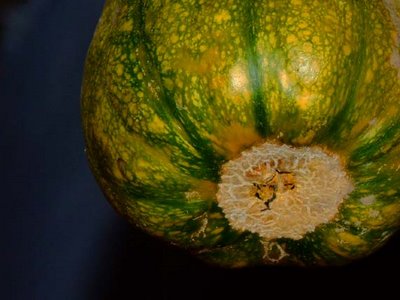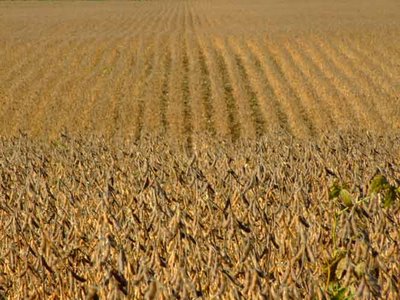 I made it outside for about 30 minutes today. We still have no snow but I do have a nasty virus. 'nuff said.
I made it outside for about 30 minutes today. We still have no snow but I do have a nasty virus. 'nuff said.Thursday, December 28, 2006
No Snow
 I made it outside for about 30 minutes today. We still have no snow but I do have a nasty virus. 'nuff said.
I made it outside for about 30 minutes today. We still have no snow but I do have a nasty virus. 'nuff said.
Labels:
Butter and Eggs,
December,
Linaria vulgaris,
Wild Flowers
Tuesday, December 19, 2006
December Sunrise
We had about five minutes of sunshine just as the sun came over the horizon this morning. This young walnut tree caught some of the first light.
I have been wanting to capture the beauty of the Wild Raspberry canes all fall. This is my best so far and still I am not quite satisfied as they are so striking to the eye everytime one passes by.

Labels:
December,
Raspberry Canes,
Sunrise,
Walnut Tree
Sunday, December 17, 2006
December Flowers cont.
I still found about a dozen species in bloom this weekend in the Hamilton/Burlington area. Here is a photo of the Purple Dead Nettle.


Saturday, December 16, 2006
Holiday Question about False Mermaids
Just in case you holiday time was in jeopardy because you did not know where False Mermaids go when they die, I am coming to the rescue. OK, maybe it was not the first question you had in your head this morning; however, I still have an answer. Almost all of them dry up, fall down, decompose, and turn back into soil like most of us will, one way or another. However; some go on a different journey. Some False Mermaids . . . oh, just in case you don't know any False Mermaids, they are small, wild plants with the Latin name Floerkea proserpinacoides. Any way, some False Mermaid are collected from the field and put into a drying press, usually along with various other plants. The plants will stay in the press until they are quite dry and then be put onto acid free paper with a label and glue carefully applied. Back into another press they go until the glue dries. When they come out of that press, they stop by a computer to have their name and address, etc. put into a data base and finally they will come to me, if they happen to go through this process at the Royal Botanical Gardens in Burlington/Hamilton, Ontario. I add a number to the label from an organizational book that has numbers for almost every plant genus. That number determines where in the files the plants will go.

Of the 80 000 specimens that are at the RBG Herbarium, some are more than 200 years old and some were put on the shelves yesterday. Some are special plants that were first found and identified at the herbarium. Some are duplicates that are destined to move to other herbariums. Most stay in their files for study by students and others concerned with plant identification, changes in plants, and changes in plant populations in various environments
It has been my privilege, since retiring as an elementary school teacher, to volunteer one half day a week for the last several years in this herbarium where I have learned much more than I ever knew about plants and been of some help to the herbarium and RBG in the process.
 The RBG (Royal Botanical Gardens) has 33 large file cabinets with about 80 000 plant files so one has to take some care in placing the False Mermaid in the correct place so it can be found again.
The RBG (Royal Botanical Gardens) has 33 large file cabinets with about 80 000 plant files so one has to take some care in placing the False Mermaid in the correct place so it can be found again.

The files are colour coded. There is a colour for RBG property plants, for Hamilton/Burlington plants not on RBG property, for Ontario plants not in Hamilton/Burlington, for wild plants in other parts of the world, for garden plants planted at the RBG, and for garden plants planted in other gardens around the world.

Of the 80 000 specimens that are at the RBG Herbarium, some are more than 200 years old and some were put on the shelves yesterday. Some are special plants that were first found and identified at the herbarium. Some are duplicates that are destined to move to other herbariums. Most stay in their files for study by students and others concerned with plant identification, changes in plants, and changes in plant populations in various environments
It has been my privilege, since retiring as an elementary school teacher, to volunteer one half day a week for the last several years in this herbarium where I have learned much more than I ever knew about plants and been of some help to the herbarium and RBG in the process.
Labels:
December,
False Mermaid,
Floerkea proserpinacoides,
Plants
Thursday, December 14, 2006
Thursday Walk
I took photos for a Flickr project this morning on the dog walk. The first item to catch my attention were backlit Goldenrod leaves.

Just a few metres on down the trail, I found this Wild Cucumber pod hanging from a tree.


Just a few metres on down the trail, I found this Wild Cucumber pod hanging from a tree.

Then, looking out over the field, I saw the sun catching the seeds of old Aster plants. A telephoto with wide f-stop shot made the surroundings blurry but beautiful.

Labels:
December,
Goldenrod,
Late Fall,
Macro photos,
Plants
Friday, December 08, 2006
Snowy December Flowers
It was snowing today and COLD for a difference. (OK, it was only -5 C with a wind chill of -12 but it felt cold.) In spite of the snow and cold, the Common Chickweed was blooming.

The Common Tansy was still hanging on.

But I was having difficulty by the time I got to this rose. My fingers and thumbs were going numb with cold and the wind was blowing so this rosebud does not look very sharp but I wanted to show it anyway as this rose still want to bloom if it gets some sun and warmer weather.
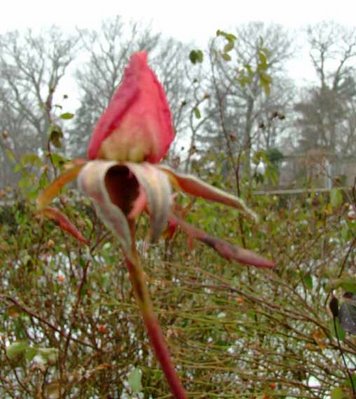

The Common Tansy was still hanging on.

But I was having difficulty by the time I got to this rose. My fingers and thumbs were going numb with cold and the wind was blowing so this rosebud does not look very sharp but I wanted to show it anyway as this rose still want to bloom if it gets some sun and warmer weather.

Labels:
Common Chickweed,
December,
Late Fall,
Macro photos,
Plants,
Rose,
Tansy,
Wild Flowers
Wednesday, December 06, 2006
First Snow Cover
Finally, on December 5,we had our first snow cover. It was not much and it's gone today, December 6, but at least we know that winter is on its way. Below is the first sunrise over snow.

The sun caught some colour on the Fir trees just outside our library room window.

From the barn, the frost on the window makes neat patterns.
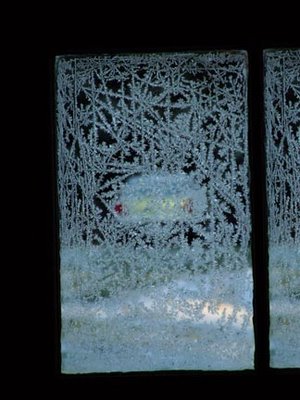

The sun caught some colour on the Fir trees just outside our library room window.

From the barn, the frost on the window makes neat patterns.

Thursday, November 30, 2006
End of November
Southern Ontario, near Hamilton and Toronto, is having very strange weather for the end of November. Yesterday the Spring Peeper frogs were singing and we found a Forsythia bush in bloom. The record high temperature for Hamilton on November 29 was 15.1 C. Yesterday, the temperature reached 15.3 C.

Above is a photo of one of 42 wild flowers that I found last week still in bloom. It is the Heath Aster (Aster ericoides). It is still blooming in our east meadow.

Above is a photo of one of 42 wild flowers that I found last week still in bloom. It is the Heath Aster (Aster ericoides). It is still blooming in our east meadow.
Thursday, November 23, 2006
Frosty Morning
Sunday, November 12, 2006
Mushroom Find
Saturday, November 11, 2006
Waterfront Trail Walk
While I was out on Friday looking for wild flowers still in bloom, I could not help but stop for some late fall colour. The willows, shown here, as well as oaks and beeches still have leaves hanging on to the twigs. The colours and the reflections in the water caught my eye.

As I walked a bit further along the trail some rustling in the leaves at the side of the trail caught my attention and . . .
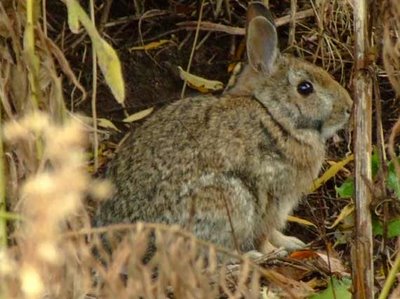

As I walked a bit further along the trail some rustling in the leaves at the side of the trail caught my attention and . . .

Wednesday, November 08, 2006
November Wild Flowers

I thought there might be one or two people interested in what the Hamilton Naturalists' Club members and I found on a November wild flower walk that I led last Saturday, November 4. (Actually, I added a few others that I found on November 1,2, & 3 in other Hamilton locations.) Altogether we found 71 species in bloom. The names are below with an * beside the names of plants that are NOT native to our area but have naturalized nevertheless.
Alyssum, Hoary *
Aster, Arrow-Leaved
Aster, Calico (Starved Aster)
Aster, Frost
Aster, Heath
Aster, New England
Aster, Panicled
Avens, Wood *
Beggar Tick
Beggar Tick, Tall
Bittercress, Hairy *
Black-Eyed Susan
Bugleweed, Rough
Bugloss, Viper's *
Butter-And-Eggs *
Catnip *
Chickweed, Common *
Chicory *
Cinquefoil, Rough
Cinquefoil, Rough-Fruited *
Cinquefoil, Silvery *
Clover, White Sweet *
Coneflower, Tall
Daisy, Oxeye *
Dandelion, Common *
Dead-Nettle, Spotted *
Dogwood, Red-Osier
Evening Primrose, Common
Fleabane, Daisy
Galinsoga, Small-Flowered
Goldenrod, Blue-Stemmed
Goldenrod, Canada
Goldenrod, Lance-Leaved
Goldenrod, Tall
Goldenrod, Zigzag
Groundsel, Common *
Harebell
Horehound, Black
Horseweed
Knapweed, Blackish (Tyrol Knapweed)
Knotgrass, Common *
Knotweed, Japanese *
Knotweed, Pink
Mallow, Common (Cheeses) *
Mayweed *
Medick, Black *
Motherwort *
Orach
Pennycress, Field *
Peppergrass, Wild
Periwinkle *
Pokeweed
Queen Anne's Lace *
Ragweed, Common
Rocket, Dame's *
Saint Johnswort, Common *
Scorpion-Grass, Blue *
Silverweed
Smartweed, Water
Sow Thistle, Common *
Sow Thistle, Field *
Sow Thistle, Spiny-Leaved *
Spurge, Petty *
Storksbill *
Teasel *
Touch-Me-Not, Spotted
Vetch, Cow *
Vetch, Crown *
Wallrocket
Witch Hazel
Wood Sorrel, Yellow
If there is any interest in getting Latin names for the flowers, have a look at my wild flower web site.
Monday, November 06, 2006
Ants View
If you've read the sidebar of this blog, you know that Églantine and I both post photos on a web site called Flickr. Within Flickr, there are lots of photo pools and one that I belong to is called Utata. This pool often puts up challenges for photos and this past weekend's challenge was to make a photo from an ant's view. Following are my contributions:
First, and I think my best, is an ants view of a Milkweed seed that just landed on a Mullein leaf.

Second is an ants view of Solomon Seal leaves and a stem.

And lastly was an ants view looking skyward towards a Mullein and a Queen Anne's Lace.
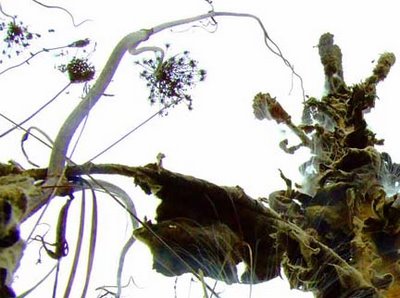
First, and I think my best, is an ants view of a Milkweed seed that just landed on a Mullein leaf.

Second is an ants view of Solomon Seal leaves and a stem.

And lastly was an ants view looking skyward towards a Mullein and a Queen Anne's Lace.

Wednesday, November 01, 2006
Dundas Valley Walk
Had problems with Blogger yesterday and could not upload the photos so this a a day late.
-----------------------------------
On October 31 I had the opportunity to walk in the nearby Dundas Valley for almost an hour. I thought some of you might be interested in what I saw.
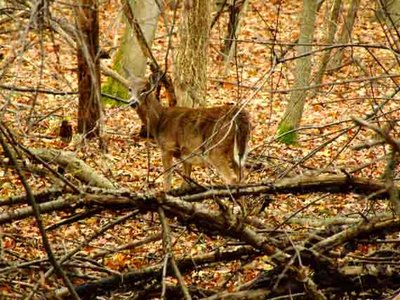
My first sighting was a White-tailed Deer. I believe that it was fairly young and had never heard of a hunting season, or knew that it was in a protected conservation area, as it did not immediately run away.

Not only did it not run away, it did not walk very fast either. During the next half hour, I was able to get closer to it than I have been to a grown deer. (I've managed to touch a fawn twice in my life by just being in the right place at the right time, but I did not have a camera with me either time.)
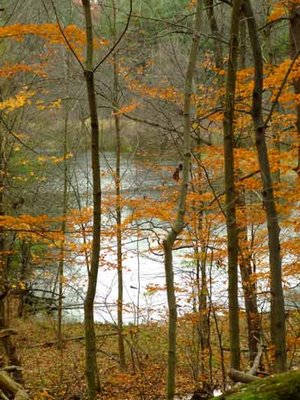
Just a bit further along the trail I found this beautiful tree shaded pond in the valley.

And not far from the pond, this Herb Robert was still blooming and putting on seeds.
All together during the last seven days of October, I found 62 wild flower species in bloom. See the full list and a couple more photos at my wild flower web site.
-----------------------------------
On October 31 I had the opportunity to walk in the nearby Dundas Valley for almost an hour. I thought some of you might be interested in what I saw.

My first sighting was a White-tailed Deer. I believe that it was fairly young and had never heard of a hunting season, or knew that it was in a protected conservation area, as it did not immediately run away.

Not only did it not run away, it did not walk very fast either. During the next half hour, I was able to get closer to it than I have been to a grown deer. (I've managed to touch a fawn twice in my life by just being in the right place at the right time, but I did not have a camera with me either time.)

Just a bit further along the trail I found this beautiful tree shaded pond in the valley.

And not far from the pond, this Herb Robert was still blooming and putting on seeds.
All together during the last seven days of October, I found 62 wild flower species in bloom. See the full list and a couple more photos at my wild flower web site.
Sunday, October 29, 2006
October Colours
Saturday, October 28, 2006
Mystery Larvae
I found six larvae in a section of limb that I was splitting today. The limb was about 20 cm (8 inches) in diameter and damp in the middle where the larvae were found. The largest larva was about 2.5 cm (1 inch) long. It fell out of the limb as I split the limb down the middle with my axe.
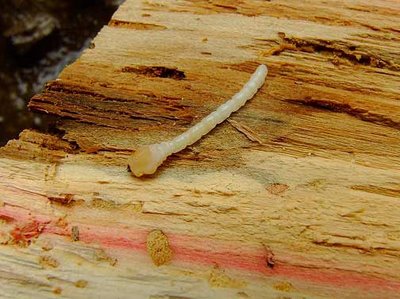
While I was photographing it, I saw three more, much smaller larvae in the wood and brought them to the surface with a splinter. Initially they were curled up in what I assume were defensive positions. After a few minutes they started to uncurl.
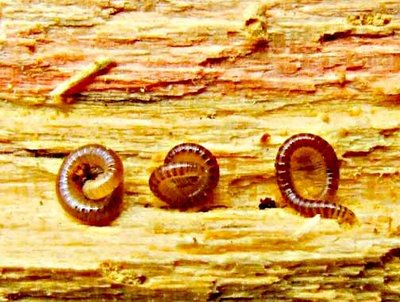
After they uncurled, they appeared to be about 1 cm (0.4 inches) long.
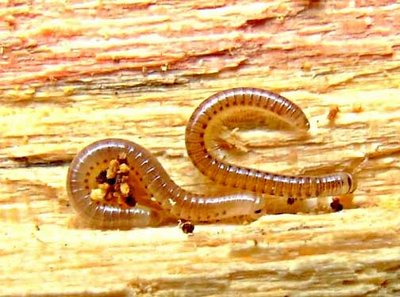
I also saw two much smaller larvae that I was unsucessful in photographing as they were too small to make much of an impression in the camera.
So my question is, what do you think they are. After some thought, I am leaning towards identifying the three small larvae as centipedes due to the way they were moving and I think I can see many, many, very small, almost transparent legs on their bodies but the larger larva has me quite puzzled. Any ideas?

While I was photographing it, I saw three more, much smaller larvae in the wood and brought them to the surface with a splinter. Initially they were curled up in what I assume were defensive positions. After a few minutes they started to uncurl.

After they uncurled, they appeared to be about 1 cm (0.4 inches) long.

I also saw two much smaller larvae that I was unsucessful in photographing as they were too small to make much of an impression in the camera.
So my question is, what do you think they are. After some thought, I am leaning towards identifying the three small larvae as centipedes due to the way they were moving and I think I can see many, many, very small, almost transparent legs on their bodies but the larger larva has me quite puzzled. Any ideas?
Sunday, October 22, 2006
October Colours

On my October 20th personal wild flower search, I found 61 species in bloom. On one hand, that is amazing for this late in the year. On the other, since I have been out almost everyday someplace looking for flowers and have been helped by groups that I've led at least once each fall in late October for over 20 years, I do know where to look and have a good idea about what flowers will bloom this late. It also helps that the temperatures are warmer than they used to be.
The trees on our home property have mostly lost their leaves and it looks more like November than October here, but down by Lake Ontario, Hamilton Harbour and Cootes Paradise where the waters keep the land even warmer, the tree colours and wild flower blooms have held on later. Oh, the bird in the photo holding its wings out to dry is a cormorant. They are very common these days on the edge of Lake Ontario.
Monday, October 16, 2006
Horseradish Harvest
Can you believe that I am still waiting for my main computer from a shop that prides itself on a two day, or less, return? Today is day 15. Sigh!
Meanwhile, out in the nearby fields . . .

Here is a closer look at some horseradish plants.

The first step in harvesting this root crop is to get rid of the tops. The tops are cut, shredded, and blown back onto the field.

Next, this large machine is pulled by another tractor over the rows. The roots are dug up, dirt shaken off, and then two individuals are doing something to the roots as the machine moves the roots to them. Maybe they are sorting? I really don't know.

They are then loaded into a truck or trailer and moved on to some unknown location. I think I need to follow both the soybeans and horseradish roots further along to see what happens next.
Meanwhile, out in the nearby fields . . .

Here is a closer look at some horseradish plants.

The first step in harvesting this root crop is to get rid of the tops. The tops are cut, shredded, and blown back onto the field.

Next, this large machine is pulled by another tractor over the rows. The roots are dug up, dirt shaken off, and then two individuals are doing something to the roots as the machine moves the roots to them. Maybe they are sorting? I really don't know.

They are then loaded into a truck or trailer and moved on to some unknown location. I think I need to follow both the soybeans and horseradish roots further along to see what happens next.
Monday, October 09, 2006
Landscape Painting # 1
Sunday, October 08, 2006
More Soybean Harvest Photos
Subscribe to:
Posts (Atom)








